Technology construction of wooden frame houses. Features of construction of frame houses, pros and cons technology. Determining the characteristics of the soil for the construction of the foundation
Frame house - Perhaps the most economical type of construction. This often lies the secret of its popularity among many landowners. According to builders' estimates, wood savings compared to construction from a bar may be up to 65-70%. Architects refer to framework projects so that the cost of the finished home remains in mass demand. What kinds frame houses offer us builders? Consider in order.
Easy, the whole object is much easier, which makes it cheaper in construction and more practical for the user. Free expansion, skeletal objects can be loosely extended at any time without using an existing building without unnecessary destruction, it is much easier, cheaper and faster than in a traditional building.
Low acoustics We reach using the appropriate mineral wool in the external walls, ceilings, partitions and media. Skeletal house can not be like a wooden. Its external walls often end with the same materials as traditional brick houses: plaster, cover with plates, imitating clinker or clinker brick. Of course, they can be covered with siding or boards - materials typical of light buildings. Interesting aesthetic effects combine various facades. The most common is thin layer plaster and clinker-imitating tile.
Frameworking technology of the house "Platform"
Technology frame construction at home "Platform", it is the so-called "Canadian", at the time gained great popularity on numerous country construction projects. This technology is indeed widely used in Canada, and even in the neighboring with us and similar climate of Finland. In 2000, the Book of the Finnish author Mikko Villacainen "Individual House" Platform ", this manual for construction of frame houses.
There is also plasterboard with wooden board and even siding with a clinker. The choice of facade material is a matter of taste, but it is important to remember the significant difference in the cost of facades from different materials, as well as the difference in the degree of complexity and time. The easiest and most economical way of laying is siding and facade of cement fiber tiles, pre-coated with plaster or aggregate.
The inner part of the building can be freely placed, since almost all structural and external forces are transmitted to the "side" walls. The house in skeleton construction towards traditional homes with the same building of the building has a much greater useful area due to the smaller wall width.
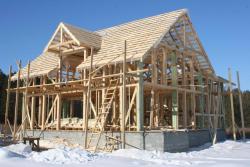 The essence of the method
The essence of the method
The house is based on a substantially, while the lower and inter-storey overlap are at the same time working planes, in which the walls of this floor are collected in a horizontal position and then installed vertically. Technology construction frame houses quite simple in its performance and not only any construction companyBut also a person who owns the Aza carpentry skill. Everything you need to build a frame can be found on the nearest construction database: frame racks, lags, rafters, insulation, finishing material. Of all breaks of frame houses You can select the two most popular types of design: frame platform and skeleton with pass-through racks.
Russian typical projects of frame houses: opportunities for savings
The useful area of \u200b\u200bthe house makes a skeletal house even more expensive, because we get an additional space for which you do not need to pay. Healthy wood house as a natural raw material, which has the ability to independently regulate moisture, creates unique, hard-to-reach in other technologies microclimate building interior. In countries where timber, statistical resident of these houses lives a dozen or more years.
The cost of living skeletal house is very warm, combined with high-quality material and professional execution to significantly reduce the cost of your home. Short construction time. Construction of a folding house on a construction site in a closed state takes about a month.
Platform frame design involves a package principle of construction. The floor overlap is assembled, which is subsequently used as the base for the walls. After installing the walls on top, they make another overlap, it can be the floor of the second floor or the base for the devices of the attic overlap. This method allows you to build a house with attraction minimum quantity labor force, which is very important for an individual developer.
Order During construction, the assembly and decoration of such a house is dry, therefore there are no problems with burdensive cleaning of the site after construction. Lightweight home lightweight wooden structure home minimizes the size of the foundations, which makes them less expensive and less expensive for transporting materials on and from the construction site itself.
"Dry" technology. The construction of the house is limited to the assembly of wooden elements, nails and metal parts, so there is no technological fault, which significantly reduces the construction time. The ability to build at home even in winter. In addition to the foundations, the wooden house does not require any wet work, such as concrete or brickwork, so winter can be built in the winter.
After installing the walls of the house, roof is erected, insulation of the walls of the house, installation of communication networks, installation of windows and doors is carried out. The final stage of construction is the internal and exterior decoration of the walls of the house. The platform system is particularly well suited in the construction of small individual houses.
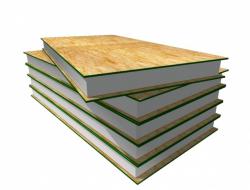 Special place in Canadian technology construction of frame houses occupied sIP Sandwich Panel (Structural Insulated Panel - Construction Heat Pole, or KTP). The SIP panel (SIP) is a monolithic three-layer design consisting of two OSB-3 plates (OSP-3), between which the insulation layer (expanded polystyrene) is glued under pressure.
Special place in Canadian technology construction of frame houses occupied sIP Sandwich Panel (Structural Insulated Panel - Construction Heat Pole, or KTP). The SIP panel (SIP) is a monolithic three-layer design consisting of two OSB-3 plates (OSP-3), between which the insulation layer (expanded polystyrene) is glued under pressure.
Simple reconstruction and upgrades. Building wooden houses It makes it easy to upgrade, expand or upgrade, for example, in the wall area, or repair or replace the installation. The low thickness of the walls of the outer walls, which is filled with thermal insulation, allows minimizing the thickness of the outer walls, so that wooden houses with the same external dimensions have a surface area of \u200b\u200babout 10% more than brick houses.
Good thermal insulation of the house The outer walls and roofs over the entire surface are lined with vapor barrier and full thickness filled with thermal insulation, which affects the high thermal insulation of the outer walls and provides low operating costs. Easy modernization due to a wooden design skeletal house is easier to upgrade and rebuild. Even the replacement of internal systems is possible without the hassle of the forging of walls and ceilings.
Benefits of housekeeping of houses
The construction process does not require heavy lifting equipment, since parts of the frame are small and weight. Roof rafters can also be lifted using simple lifting tools. Due to the fact that the construction is conducted by "layers", the scaffolding will be required only when the facade is trimmed. Also do not need to build special stairs for the construction time. The staircase on the top floor can be done immediately after assembling an inter-storey overlap. If the staircase is thoroughly closed or finished or finished it only at the end of construction, then you can not be afraid of its premature wear.
Council
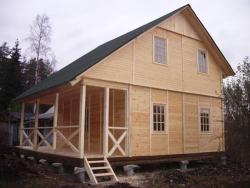 For wooden carcass construction The following materials are needed: the timing of 100x100 mm (100x150 mm for the northern regions), also for the framework of the framework, you can use log in diameter 12-14 cm, cutting board 50x100 (150), 25x100 (150) mm, mortgage bar or birch. Wood moisture for the carcass device should not be more than 15%.
For wooden carcass construction The following materials are needed: the timing of 100x100 mm (100x150 mm for the northern regions), also for the framework of the framework, you can use log in diameter 12-14 cm, cutting board 50x100 (150), 25x100 (150) mm, mortgage bar or birch. Wood moisture for the carcass device should not be more than 15%.
If you plan to build a single-level house, then the frame racks can be made of 50 mm thick boards, but if you decide to build a two-level house, then it is better to be reinforced and used for the bearing racks with a cross section of at least 100x100 mm.
 Houses with a frame of lung metal structures - Another direction of development of low-rise frame house-building. Conservative Russian citizens are still looking at this technology, trying to compare all its advantages and disadvantages, although all over the world it has long been popular.
Houses with a frame of lung metal structures - Another direction of development of low-rise frame house-building. Conservative Russian citizens are still looking at this technology, trying to compare all its advantages and disadvantages, although all over the world it has long been popular.
The construction technology of prefabricated buildings based on steel structures has long been used in different countries. First, industrial and commercial facilities, warehouse terminals were erected on steel frames, and then the technology was adapted to housing construction, where it gained active development. Russian builders recently began to use steel frame in low-rise house-building.
 Metal frame for home Collected from lung steel structures. Vertical racks and horizontal liters are made of galvanized perforated profile (low alloy steel) with a thickness of up to 3.5 mm. All elements of the frame design are connected to each other with ripples or screws. Then the frame is cut on both sides by hand or leafy materials, inside which the insulation is laid, with vapor barrier and windproof membrane (everything is in houses with a wooden frame). The use of thin steel profiles limits the height of the builded structures, as a rule, by two floors.
Metal frame for home Collected from lung steel structures. Vertical racks and horizontal liters are made of galvanized perforated profile (low alloy steel) with a thickness of up to 3.5 mm. All elements of the frame design are connected to each other with ripples or screws. Then the frame is cut on both sides by hand or leafy materials, inside which the insulation is laid, with vapor barrier and windproof membrane (everything is in houses with a wooden frame). The use of thin steel profiles limits the height of the builded structures, as a rule, by two floors.
To increase the passage of the heat flux so that the "cold bridges" is not formed, through grooves with a minimum cross section cut through the profiles in checkerboard.
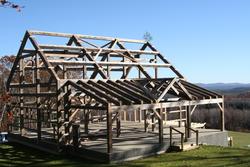 German carcass home-building technology
German carcass home-building technology
The essence of the method: Describing the method of building a "platform", it should be noted that the so-called German technology is, in fact, the same, with the only difference that the wall panels of the house in the German version are always used factory. Hence the traditional German accuracy, - the shields are fitted and the thermal insulation material, the windows and the primary wall decoration are also made. Assembling floor overlap is also made in factory conditions.
The principle of bonding shields of the houses at home is the same as the houses built according to the "platform" technology. For delivery and erection of the house requires a lifting technique, which, unfortunately, makes construction more expensive.
Advantages of German frame house-building
First of all, this is the high quality of the assembly, the revolving side of which, must be recognized, becomes a higher price. During the construction of the walls of the house from the factory manufacturing panels, you can be as confidential as possible in accuracy of technology. Construction technology frame house In particular, German, it implies that all elements of the precast building have standard, unified dimensions. This allows finishing operation of a frame object by any materials. At the same time, the developer does not spend time on the preparation of external and internal surfaces, because frame construction of houses Lained uneven walls, ceilings and floors, window curves and doorways.
Tip:
The first thing they do (should do) builders after the construction of the walls is to close the roof. After all, the panels are undesirable to direct moisture in the course of a long time. The outer walls of the house can stand without finishing for three months. After that, the OSB plates will begin to darken away from precipitation, so it is better to calculate your capabilities in advance and get facade trim as soon as possible.
 Frame construction: Questions and Facts
Frame construction: Questions and Facts
Why are many future homeowners refuse such a quick and profitable domain of house-building? The first and main claim is, of course, the "non-environmental friend" of such housing. However, manufacturers claim: all materials included in the sandwich panel have certificates and sanitary and epidemiological conclusions, they are specially designed for residential premises and are completely safe.
The second minus, which, however, is inherent in all frame houses - It is bad sound insulation. However, this problem is solved at the stage of finishing work with noise and sound insulation materials.
The third complaint to the quick-scale housing from the sandwich panels is his fire hazard. In fact, panel-frame houses belong to the same flagrance class, as wooden, and need the same complex of protective measures as cottages from a log or bar.
And the last "big question". Many customers initially belong to the panel-skeletal housing as unreliable and short-lived. However, impartial mathematical calculations and successful overseas practice refute these fears. The estimated shelf life of this house is eighty years. For example, in Canada, you can see strong buildings built on this technology more than half a century ago. Therefore, if the future owner does not plan to build housing at least two hundred years, the version of the panel-frame cottage may be perfect for him.
 Russian typical projects of frame houses: opportunities for savings
Russian typical projects of frame houses: opportunities for savings
Plant Volume-modular buildings in Pereyaslavl-Zalessky releases frame wooden houses With external and interior decoration and built-in engineering communications. The dimensions of the products are such that their transportation is possible for any distance railway or vehicle. On the stream - three typical projects of houses with dimensions of 3.2x11,4; 3.6x11.4; 4.2x11.4 m. Two versions of the ceiling altitude: 2.5 and 2.7 m. The frame is made of glued timber, both parts of the bartal roof are connected by hinges.
The basis of the house is the framework and light beams for inter-storey floors of galvanized profiles. The thermal insulation is provided by 150 mm layers of Rockwool mineral wool. For roughing and wind protection, a CSP (cement-chipboard) is used or a new CML material (fiberglass-magnesium sheet) of Chinese production, which has been widespread in Korea and Japan.
Manufacturers from the Leningrad region offer more than 20 typical projects of houses. These are skewing single, two-storey houses Square from 67 to 200 sq.m. The frame consists of a rectangular bar of 150x75 mm, and the roasting is made of square 50x50 mm. Insulation serve basalt plates Rockwool; "Izospan" is used for hydro and vaporizolation. Siding applies as outer decorative sewing. The roof consists of metal tile with insulation isover. The strength of the design allows the use of both natural tiles (clay or cement-sand).
 The cost of houses without taking into account the foundation and engineering systems is as follows: houses with an area of \u200b\u200b67-100 sq. M - 400-720 thousand rubles; 102-140 sq. M - from 800 thousand to 1 million rubles; 145-200 sq. M - up to 1.5 million rubles. "Landing" russian version of a skeleton country house It becomes attractive at a price due to some changes made to the project. Instead of a bar of 150x100 mm for the bottom and upper strapping, two boards 150x50 mm are used (they, by the way, do not change their form when drying). The entire wooden frame is replaced with a metal of thin-walled structures (LSTK), which are assembled on self-drawing, without welding. Wall structures - from a tipped oriented chipboard (OSP), insulation of polystyrene foam. Outside the frame is shedding OSP, and inside - a gypsum-fiber waterproof sheet. In fact, OSP is improved three-layer wood. The chips in the outer layers are oriented along the plate, and the middle layer is across. Therefore, in the OSP plates, fastening well, and the stove itself acquires increased strength and elasticity.
The cost of houses without taking into account the foundation and engineering systems is as follows: houses with an area of \u200b\u200b67-100 sq. M - 400-720 thousand rubles; 102-140 sq. M - from 800 thousand to 1 million rubles; 145-200 sq. M - up to 1.5 million rubles. "Landing" russian version of a skeleton country house It becomes attractive at a price due to some changes made to the project. Instead of a bar of 150x100 mm for the bottom and upper strapping, two boards 150x50 mm are used (they, by the way, do not change their form when drying). The entire wooden frame is replaced with a metal of thin-walled structures (LSTK), which are assembled on self-drawing, without welding. Wall structures - from a tipped oriented chipboard (OSP), insulation of polystyrene foam. Outside the frame is shedding OSP, and inside - a gypsum-fiber waterproof sheet. In fact, OSP is improved three-layer wood. The chips in the outer layers are oriented along the plate, and the middle layer is across. Therefore, in the OSP plates, fastening well, and the stove itself acquires increased strength and elasticity.
Combining the experience of ancient craft with the possibilities of new technologies, modern frame house building The right is considered the most economical and technological option for the construction of high-quality country houses.
Expert Comment: Rosstroy
One of the options for a frame house is a ready-made household complex for year-round accommodation. When choosing a home complex, you need to pay attention to the final readiness - how much you still need to do and put it in order to bring it as they say "to mind." The environmental friendliness of materials, the energy efficiency of the enveloping structures, the speed and quality of assembly, as well as the price of assembly and delivery is also important.
What should be the modern household complex of the finished frame house: Maximum final readiness after the assembly, the original modern design of facades and interior decoration, the most efficient use of the internal space, the possibility of installation on any sections, the use of advanced and tested technologies to achieve maximum comfort and environmental friendliness, reducing the cost of further content, the possibility of extension and Superstructures, and of course the available price is fully finished to accommodate the house for the shortest possible time.
 Facrow: O. porn brusade houses
Facrow: O. porn brusade houses
Fakhverk - This is a construction technology in which the supporting structure is a hard frame of wooden beams, vertical racks, horizontal rheglels and diagonal diagonals. The secret of its strength is in the high quality of the wood used (a durable oak was used for the manufacture of beams) and jewelry compounds of wooden parts with a special wristband ("on a secret spike", "Lastochka Tail") and aging (wooden nails). The absence of any metal fasteners is the main difference between the traditional step from its later interpretations.
To protect the wooden structures from rotting (with direct contact with the earth), they were put on stone socles or the first floor of the house was completely erected from stone. And from the effects of atmospheric precipitation, the frame faced the natural structure of the wood itself - on the capillary system of vertically standing beams moisture flowed down, without lingering in the tissues of the tree. Additional protective composition of natural oils, which were covered with the elements of the supporting structure, gave wood resistance to atmospheric influences, fires and insect-affected by insects.
The essence of the method: one of the popular frames of the frame house - the half-timber. In a classical understanding, this is a hard frame consisting of wooden or metal struts, horizontal beams and diagonal squeezes. Modern firearies dictate a choice in favor of metal racks. The entire structure is holding on separately standing racks. For comparison, the framework of Canadian is formed by a frequent set of wooden racks forming a wall plane. Wall design budget option The half-timbered consists of a brick (clay) masonry with a thickness of 120 mm attached to the racks with special anchors. Then (with an air gap) go 25 mm thick, layer of minvati in 80 mm, then a layer of lime brick, which is well loving lime plaster. Alternatively, instead of bricks, a monolithic foam concrete stamps D200-D400 is used.
Wooden version Fakhverka Presses the rack 140x130, 190x175 or 190x220 mm. The bars of 40x50 and 50x60 mm are going to the inner partitions (also on the frame scheme). To the floor, columns and racks they are fixed with frame dowels. Frame racks for the frame and for rafters of the roofs are edged boards 50x100 mm, and the boards with a thickness of 20 and 25 mm - for the walls of the walls. The optimal cross section of the solid system is 50x150 mm or 50x200 mm. For the roofroom, bars and boards of 50x50 mm (40x40 mm) and 25x150 mm (25x100 mm) and 25x150 mm (25x100 mm) are used in increments between rafters about 0.9 m. A premium or business class head has the elements of the "intelligent" house: multi-layered wall sandwich designs And, of course, low-emission double-glazed windows. In half-timbers with large glazing grounds, racks are required. In this case, the cross section of angular racks is 300x300 mm, and in line - 300x180 mm. Ceiling beams are also enhanced to a cross-section of 100x80 mm, and the Bar Mauerlat - until the section is 270x90 mm.
Benefits: Facrow technology saves building materials, especially expensive wood. This is the main reason that the method has become widespread in Europe.
Moreover, frame method It allows you to significantly increase the inner space and the floors of buildings, build houses with a closer layout, unlike the chopped, where the size of the rooms were strictly limited to the log length.
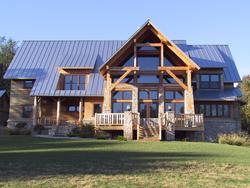 Frameworking House Building Technology - Timber Frame
Frameworking House Building Technology - Timber Frame
Historical ancestors Timber Freim. - "Fakhverk" in Germany, "Colombaz" in France, "Post-and-Bim" in England. Reliability and durability of these designs is verified and confirmed by time.
The style and technology of wooden house-building Timber Freim originated in medieval Europe. Later, during the colonization of the United States, most of the wooden houses in the new light was built along the same technology. In the 20th century, lungs cheap frame houses Thimber Freim crowded out, and he practically ceased to be in demand. But since the 70s, the revival of technology began in the USA.
 The essence of the method: Timber Freame (Timber Frame) is almost the same as the German half-timber. The main difference is thicker and massive beams. From all other framework technologies mentioned by us Timber Freim differs, first of all, the framework itself. The framework here is carrier, i.e. It is he who holds the weight of the whole house, people, furniture, etc., plus loads from snow and wind. All parts in the frame are connected, fasten with carpentry locks (spike-grooves, etc.) and are fixed with wooden brazers (wooden nails), i.e. without metallic fasteners. It makes a heavy frame very durable and durable, eliminating possible erosion of wooden beams. Each connection, each detail in the frame is individually adjusted to the other. The frame itself in Timber Freame leaves visible in the interior of the house. Wood grinds, sharp edges spin. Modern two- and more floors are often built with the second light, while the frame is performed in the form of a distributed farm, which allows you to build wide rooms without retaining columns. In German phase, a lifetime lumber is used.
The essence of the method: Timber Freame (Timber Frame) is almost the same as the German half-timber. The main difference is thicker and massive beams. From all other framework technologies mentioned by us Timber Freim differs, first of all, the framework itself. The framework here is carrier, i.e. It is he who holds the weight of the whole house, people, furniture, etc., plus loads from snow and wind. All parts in the frame are connected, fasten with carpentry locks (spike-grooves, etc.) and are fixed with wooden brazers (wooden nails), i.e. without metallic fasteners. It makes a heavy frame very durable and durable, eliminating possible erosion of wooden beams. Each connection, each detail in the frame is individually adjusted to the other. The frame itself in Timber Freame leaves visible in the interior of the house. Wood grinds, sharp edges spin. Modern two- and more floors are often built with the second light, while the frame is performed in the form of a distributed farm, which allows you to build wide rooms without retaining columns. In German phase, a lifetime lumber is used.
- Tools and Materials for Frame Building
- Determining the characteristics of the soil for the construction of the foundation
- Frame-type framework technology
- Construction of the frame of the walls of the first floor
- Erecting the second floor and roof
Frame house building is distinguished by high construction speed and low cost.
Frame houses can easily carry temperature fluctuations from -30 to +30 ° C.
This assembly technology is used in the erection of small private houses, as well as multi-storey buildings. They answer modern requirements Strength, energy efficiency and comfort of accommodation. Houses lined up frame technologycan be operated in climatic conditions where the temperature may vary in the range from -30 ° C to + 30 ° C.
For long years, such an assembly technology is underestimated, since the frame house was considered unreliable and short-lived. But, as such houses are built and the appearance of a huge number of positive feedback on them, a frame-type houses have become competitive with traditional buildings, which are based on wood and brick.
Tools and Materials for Frame Building

Tools: nail-cut, plumb, ax, corner, building level, etc.
- sotorous saw;
- screwdriver with a pair of batteries;
- electric jigsaw;
- concrete mixer;
- bulgarian;
- levels of 2 m and 60 cm;
- roulette;
- a hammer;
- hand-hacksaw;
- chisels;
- pliers;
- sand;
- cement;
- shovel;
- armature;
- knitting wire;
- ruberoid;
- waterproofing composition;
- wood;
- tara for mixing cement.
Back to the category
Determining the characteristics of the soil for the construction of the foundation

Before construction, it is necessary to decide on the type of soil on the site, where the house will be erected. If the project implies the costs of geological surveys, it will be the best option. You can and independently determine the level of groundwater and soil composition. To do this, dig a hole, the depth of which will be approximately 1.5 m, which will help to study the ground cut.
The best option will be sandy-stony soil, gravel or rock soils that do not have in the composition of clay, the large-scale ground will perform a great base without inclusions. Such a base does not hold moisture, it is not extended when freezing in the winter period. The least favorable options for the foundation will be fine-grained and dust sands, as they are pecunned in the cold. It is worth considering that clay soils with a shallow water located waters will be removed when freezing.
The service life, which is peculiar to the foundation, must correspond to the service life of the house. Therefore, in many respects, the frame house is not built on reinforced concrete belt foundations. If the plot has a high arrangement of groundwater, it is not recommended to equip the basement. Despite the fact that the type of foundation will be chosen, as well as how high-quality it will be waterproof, it will be high humidity.
If you plan to build a frame of a frame type on bulk and sailing soils, the best option will be the arrangement of a monolithic plate, which will provide spatial rigidity. For the purpose of saving, it is possible to prefer the construction of a small-breeding foundation, and different types of basics equipped on sand pillows are perfectly suitable.
In any case, the ease of design of the house frame type determines the rationality of using all types of relatively inexpensive and simple in the process of execution of foundations.
Back to the category
Frame-type framework technology

Before starting work, you should decide on the project. The frame house, like any other, should begin to build from the foundation. The assembly technology in this case differs in that it does not imply the presence of a powerful and expensive base. Extremely often such houses are built on silent-screw foundations. However, if the project of the house will have a cellar or storage room, it is necessary to prefer a tape base. The 2-storey construction will need a foundation whose width is 30 cm.
The construction of a frame house should be started with the arrangement of the trench, its depth should be equal to 50 cm, width - 40 cm. In it, it will be necessary to mount the formwork, trying the pens intended for piles, the step between them should be 1.5 m. In They are allowed to establish asbestos pipes, it is possible to limit fiber-based reinforcement. After the bottom, the sand should be covered in about 20 cm. In addition, a future foundation is also to be rejected, for this formwork must have reinforcement fixed with knitting wire. It is important to ensure that the formwork does not have a height drops, a permissible error in this case, a differential is considered to be 1-2 cm.
The fill of concrete in the formwork of the foundation of the frame house should be made at a plus temperature. It is preferable to use a ready-made concrete from the factory than producing an alternate on the site. To the house, the dimensions of which are 7x10 m, it will be necessary to use about 12 cubes of the mixture. After full of cement fill, it should be tamped, perfectly suitable for this manual vibrator. Full drying will take at least a week. If it is necessary to have a base on the finished foundation, its calculation should be made using the brick.
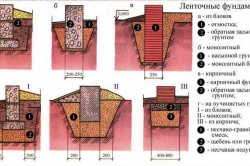
The technology of assembling such a house involves the establishment of gender and other structures using the edged board of the first grade, its thickness must be 50 mm. It should be treated with waterproofing composition, setting over 2 layers of the rubberoid. It should be put on its surface, which will be the basis of the Future Floor frame.
OSB sheets will perform a black floor tie, the dimensions of which should be equal to 1250x2500, and they should also be processed using a special composition, which will prevent the spread of mold and fungus. Mounting transverse lags in the house should be applied by a step of 575 mm. Details should be fixed on wood screws. We should not forget that this stage of the assembly of frame houses involves the arrangement of the stroke into the subfield.
In order to ensure the convenience of further work and give the stiffness of the entire design, the floor should be seen by the sheet material, which in the future should be replaced by sex boards or concrete tie.
Screen OSB is needed to each lag. Works associated with wood frame, preferably carry out in dry weather.
Back to the category
Construction of the frame of the walls of the first floor
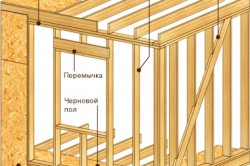
After installing the floor, you can begin the construction of the frame of the 1st floor. It is more convenient to assemble the walls of the walls on the floor, and after it is ready, you can start it with its installation and fixation, which is performed using the strut, while it is necessary to achieve the necessary stiffness. The system of external walls of frame houses is assembled with the use of a board, the cross section of which should be 50x150 mm, and when assembling internal supporting partitions, the connection of 3 boards should be used together, so it will be possible to obtain dimensions in 150x150 mm.
The most common facing material is moisture-resistant OSB 3. In order to provide a more convenient mount, the step should be held between adjacent vertical racks, which is 575 mm. Sheets to strengthen the screws or nails.
In the process of manufacturing the framework of such houses, window openings should be additionally enhanced by connecting 2-3 vertical boards, which will protect them from the drawdown after the construction of the entire building is completed.
The assembly technology, after lifting and fixing the walls, implies the installation of internal partitions. Before starting the rise of the second floor, the installation of bearing structures should be made. It will be done from reinforced boards, which are attached with the help of the corners.


